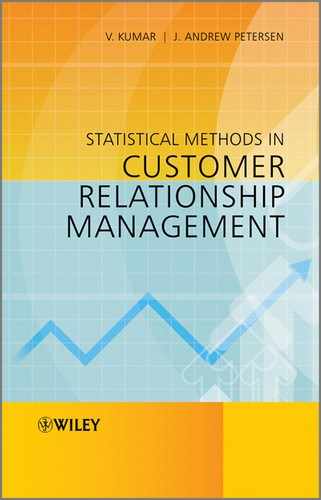2.1 Introduction
A survey over the past few years would reveal that successful companies have been the ones that have placed emphasis on and modeled their business practices around customer relationships. This is true for companies across industries, geographical markets, and product offerings. Companies such as Zappos, IBM, and Continental Airlines have become leaders in their respective domains by implementing CRM programs in their organizations. By leveraging the combined power of database, technology, and statistical models, companies have been able to model their entire marketing process around customer relationships – in most cases, at the individual customer level. Gartner Research has predicted that the healthy growth of CRM will continue through 2012, when total worldwide CRM software revenue will reach $13.3 billion. Further, the market for CRM software in North America is projected to reach $7.6 billion in 2012 [1]. With so many resources being directed toward CRM activities, it is important to understand this investment from a managerial viewpoint.
Traditional marketing theory and practice have always advised managers to identify ways to enhance revenues and maximize profits by expanding the customer base. While this may be a viable strategy, it does not always work. For instance, in mature industries and mature markets, customer acquisition may not hold the key to better financial performance. Although we can assume that maximizing profitability is the goal of the firm, we cannot assume that simply maximizing key measures such as customer acquisition and customer retention is the most efficient way to accomplish this goal. What firms must realize is that higher acquisition rates and retention rates, for example, do not necessarily result in higher profitability [2]. Key customer metrics such as acquisition, retention, churn, and win-back certainly are essential for establishing a profitable CRM strategy; this does not mean, however, that ‘maximizing’ each individual metric is the correct recipe for success. Although identifying these metrics is certainly a crucial step in achieving successful CRM implementation, managers cannot stop there. Where these metrics truly become valuable is in answering questions that determine the correct approach in implementing them. Existing modeling approaches suggest that implementing specific and tailored strategies for key customer metrics yields a greater impact on customer decisions and can therefore lead to higher profitability. Managers need help in developing these specific strategies in each of the four steps of the customer–firm relationship life cycle: acquisition, retention, churn, and win-back.
Using a powerful metric such as CLV, firms can address marketing issues with greater accuracy. This metric will help companies develop important CRM strategies in each of the four steps of customer–firm relationship that will help enhance firm performance. Figure 2.1 illustrates the strategies, known as the Wheel-of-Fortune.
Figure 2.1 Wheel-of-Fortune strategies. (Adapted and updated from Kumar, V. (2008) Managing Customer for Profit. Prentice Hall, Upper Saddle River, NJ.)

The Wheel-of-Fortune strategies illustrated in the figure provide answers on one or more of the four tasks pertaining to customer acquisition, customer retention, customer churn, and customer win-back. To generate such targeted strategies, it is essential to develop appropriate statistical models that can help managers generate the necessary insights. The following sections highlight the importance of understanding acquisition, retention, churn, and win-back, and how they are integrated into the CRM playbook of an organization. Following this brief introduction, the subsequent chapters in this book delve deeper into the model development process in each of these four areas.
